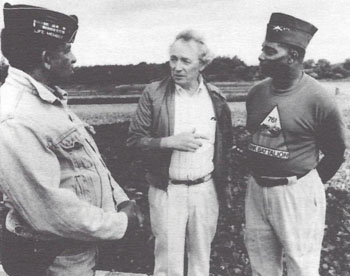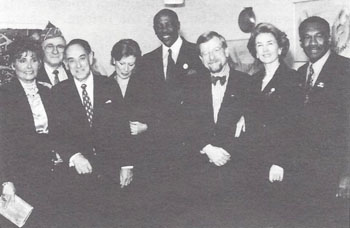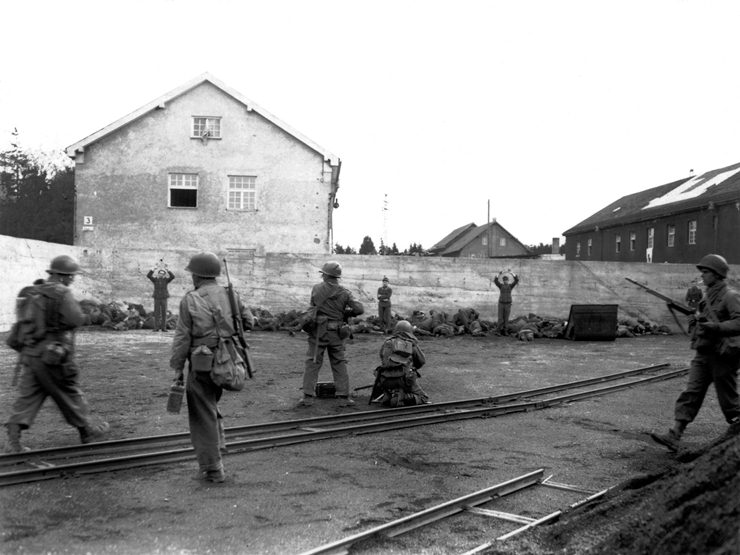Multi-Media “Liberators” Project Exposed as Fraud
Historical Truth Survives "Politically Correct" Exploitation
Exposing historical and media fraud sometimes takes years or even decades. In the case of a recent heavily promoted and widely praised multi-media project – designed to promote the Holocaust story, condemn official racism against blacks in America during the Second World War, and encourage racial tolerance – debunking has come much more quickly.
Liberators: Fighting on Two Fronts in World War II – a lavishly financed project that claims to tell the story of how black troops liberated Buchenwald and Dachau – was exposed as an error-packed fraud within weeks of its debut.
Producers Nina Rosenblum and William Miles collaborated with author Lou Potter, on the slickly promoted project that includes a much-touted “documentary” film, a book, a high school workbook, a screenplay and a theatrical version. Even before its public debut, “Liberators” had garnered impressive national and international support.
Typical of the hype was the praise by Publishers Weekly (Oct. 19, p. 32), a leading publishing trade periodical:
It’s been a long time in coming, but Liberators: Fighting on Two Fronts in World War II, as a book, a TV documentary, a workbook for high schools to accompany the documentary, and a theatrical feature, is going to make its presence felt. This is the story, not found in standard historical accounts, of the role played by the 761st Tank Battalion in freeing the prisoners of Dachau and Buchenwald.
Jesse Jackson presented a copy of the sumptuous book version of Liberators (published by the prestigious firm of Harcourt Brace Jovanovich) to President-elect Clinton. The black leader also announced that, with financial backing from financier Felix Rohatyn, he would distribute copies to every school library in the United States.
Gala Premiere
New York Mayor David Dinkins introduced the “Liberators” film at its premiere showing on November 9 at a star-studded gathering of more than 700 leaders of the city’s Jewish and black communities. The gala event at New York’s Lincoln Center was co-sponsored by the US Holocaust Memorial Council (a taxpayer-funded federal government agency) and WNET television (New York City’s prestigious PBS station).
Referring obliquely to the high level of tension between the city’s Jews and blacks, Dinkins said: “… When we see those brave African-American soldiers freeing Jewish prisoners of concentration camps, let us remember all that binds us together.” Reporting on the premiere showing, the US Holocaust Council’s (Winter 1992–93) Newsletter similarly boasted that the film “offered a rare opportunity for reconciliation and communication between two of New York’s most prominent ethnic groups.”
Two days later (Veteran’s Day), WNET broadcast “Liberators” nationally on the PBS television network as part of its prestigious “American Experience” series. In mid-December, Jesse Jackson introduced the film at its showing at the Apollo Theater in Harlem, a high-profile event sponsored by media giant Time Warner and a host of rich and influential New Yorkers. (New Republic, Feb. 8, p. 13; New York Guardian, March 1993)
Truth Emerges
Because its errors are so blatant and readily discernible, it wasn’t long before critics began pointing them out. The first periodical to take aim was a relatively obscure monthly, the New York Guardian. In its December 1992 issue, the paper reported:
After an intensive examination of Army records and interviews with military historians, Holocaust experts, [and] World War II veterans including black soldiers whose lives were depicted in “Liberators,” the Guardian has learned that the most celebrated facts of “Liberators” are not true. Neither soldiers of the 761st All Black Tank Battalion nor the soldiers of the 183rd Black Combat Engineers ever liberated Buchenwald or Dachau.
Veterans’ groups and individual veterans of the 761st soon joined in, confirming that black units did not liberate Buchenwald or Dachau. Robert Abzug, professor of history at the University of Texas, and author of Inside the Vicious Heart: Americans and the Liberation of Nazi Concentration Camps, said that the Liberators book and film “violates any sense of historical accuracy.” (New Republic, March 8, p. 42)
Staged ‘Reunion’
The “highlight” of “Liberators,” reports the Winter 1992–93 Newsletter of the US Holocaust Memorial Council, is a “deeply moving reunion” at Buchenwald of former inmate Benjamin Bender “with two of his liberators,” E. G. McConnell and Leonard Smith. “In autumn 1991,” readers of Liberators (p. vii) are told:
Jewish survivors of Dachau and Buchenwald were reunited, under the auspices of the production team, with members of the 761st. The dramatic and poignant event received widespread media coverage, which led to Harcourt Brace Jovanovich’s decision to employ the publishing medium in making this exciting and previously untold story available to the widest possible audience in this country and abroad.
This “moving” and “poignant” event is a deceitful fraud. “It’s a lie,” confirms McConnell. “We were nowhere near these camps when they were liberated… . I first went to Buchenwald in 1991 with PBS, not the 761st.” (New Republic, Feb. 6, p. 13)

A fraudulent scene from “Liberators.” According to the caption to this photo in the Winter 1992-93 “Newsletter” of the US Holocaust Memorial Museum, former inmate Benjamin Bender “recalls the day the American troops freed him and his fellow inmates from Buchenwald with two of his liberators, E.G. McConnell, left, and Leonard (Smitty) Smith.” Their “reunion” here at Buchenwald is a lie. McConnell and Smith were miles away from the camp when it was liberated.
Rosenblum and Miles blatantly disregarded the truth, McConnell says: “I called their attention to it. I tried to stop them, but in the final stages they decided to deviate from the fact.” In an effort to secure his cooperation with the project, “Liberators” co-producers Rosenblum and Miles offered McConnell $11,000. He turned them down. (New York Guardian, Dec. 1992)
“Liberators,” McConnell charges, is a “distortion of black history. They [the producers] had received a lot of money from the Jewish community based on the story and they [the producers] didn’t want to change it.” (New York Guardian, Dec. 1992)
More Lies
One person who figures prominently in “Liberators” is Leon Bass, a black veteran who has made a second career speaking to gatherings sponsored by Jewish groups, and to classrooms of impressionable school children. He has been featured on the “MacNeil/Lehrer News Hour” and in other major media as a liberator of Buchenwald.
In the Rosenblum/Miles film, and in his frequent lectures, Bass calls himself a “liberator.” (New Republic, Feb. 8, p. 14) He has received numerous awards and large speaking fees for retelling his “liberation” story, and was named co-chairman of the Philadelphia Council on the Holocaust. (New York Guardian, March 1993)
In fact, though, he only visited Buchenwald – on orders – five days after its liberation.
In both in the film and the book version of “Liberators,” Bass also emotionally recounts how he and his unit, the 183rd Combat Engineers, built a bridge in a Belgian town during the December 1944 “Battle of the Bulge.” He and his men worked “… in spite of strafing by the airplanes that would come down daily and machine-gun us. In spite of the shelling of the howitzers, we worked on that bridge.” As a result, Bass continued, “many of my friends” were killed building the bridge. (Liberators, p. 190)
In fact, the only soldier to die while constructing the bridge was one officer who was killed in an accident involving his jeep. There was no strafing by German planes. During its entire time of service in Europe, the 183rd lost three of its members, all due to accidents. (New York Guardian, March 1993)
According to Liberators (p. 217), Buchenwald was liberated when
The tankers from the 761st broke through the Buchenwald gates and, with their accompanying infantrymen, quickly ended resistance from the SS guards… . Johnnie Stevens recalls: “We … shot up the place and chased the guards out of there. It was a sight I never want to see again, I’ll tell you that.
This account is sheer invention. American troops did not break through the camps’ gates (they entered on foot), nor did they shoot up the place or chase guards.
On liberation day, “recalls” former Buchenwald inmate Ben Bender, an airplane flew overhead and gunfire was exchanged. (Liberators, p. 217) In fact, the German camp guards had already abandoned the camp hours before, and there was no gunfire or planes flying overhead.
The New York Times Record of Falsehood
Over the years, few institutions have been more guilty of distorting the truth about the wartime fate of Europe’s Jews than The New York Times, America’s most influential daily paper, and an important booster of “Liberators.” (Joseph Sobran, syndicated columnist and National Review writer, once joked that the paper “really ought to change its name to Holocaust Update.”)
The New York Guardian detailed “a clear pattern of inaccurate reporting, and the employment of faulty journalistic practices” by The New York Times since 1985 in its coverage of the liberation of the German camps, and particularly the supposed role of black US Army units. The monthly paper cited eleven specific examples of such distortion of fact by the Times. (New York Guardian, March 1993)
Defending Deceit
Revealing and instructive has been the response of the project’s producers and supporters to honest efforts by those who tried to point out its errors. Co-producer Rosenblum angrily castigated her film’s critics as Holocaust Revisionists and racists. “These people are [of] the same mentality that says that the Holocaust didn’t happen,” she said. (New Republic, Feb. 6, pp. 13–14)

The “Liberators” film premiered at a gala gathering in New York City, November 9, co-sponsored by the US Holocaust Memorial Museum and public television station WNET. Among the attendees were, from left: Entertainer Lena Horne, an unidentified person, Harvey Meyerhoff (chairman of the US Holocaust Memorial Council), Nina Rosenblum (“Liberators” co-producer), actor Louis Gossett, Jr., William F. Baker, Elizabeth Rohatyn (WNET vice chairperson), and William Miles (“Liberators” co-producer).
When military affairs specialist and New York City radio talk show host Jim Dingman confronted Rosenblum about her film’s inaccuracies, she called him a “racist.” And when he tried to explain the truth to the Anti-Defamation League (which had eagerly endorsed the project), an ADL spokesperson dismissed him as a “revisionist.” (New York Guardian, Dec. 1992)
McConnell tells a similar story. When he tried to explain the film’s fraud to the Anti-Defamation League, he was sharply rebuffed. The ADL “treated me like I was a kook, or something,” he says.
While admitting that the film’s description of the “reunion” scene “may be misleading,” Rosenblum told one skeptic: “You can’t speak to him [McConnell] because he’s snapped. He was hit in the head with shrapnel and was severely brain-damaged.” Informed of this, McConnell responded: “If I was so disturbed, why did they use me in the film?” (New Republic, Feb. 8, p. 13) As it happens, McConnell is referred to on more than 20 pages of Liberators, often in direct quotes.
As criticism mounted, Rosenblum “continually encouraged the veterans to blame any challenge of the film’s veracity on bigotry” and “deflected criticism of the film by charging prejudice.” To one critic she responded by asking why he was “willing to believe a white commander and not [the black] soldiers.” (New York Guardian, March 1993)
Finally, Rosenblum tried to explain away criticism of her film by charging:
There’s tremendous racism in the Jewish community. How people who have been through the Holocaust can be racist is completely incomprehensible. To think that black people are less, which is what most Jewish people think, I can’t understand it. (New Republic, Feb. 6, pp. 13–14)
Damage Control
After the essentially fraudulent character of “Liberators” had been widely reported, the project’s most prominent backers engaged in some “damage control” and sought to distance themselves from the now-discredited production.
WNET announced on February 11 that “Liberators” was being “withdrawn” from circulation. Explaining the decision, WNET vice president Harry Chancey, Jr., referred to “the sacred nature of the Holocaust… . Rather than let this film go up like an incendiary bomb, we decided that we would withdraw the film …”
Defiance
Even so, “Liberators” still had staunch defenders. One was Peggy Tishman, a former president of the Jewish Community Relations Council of New York. “Liberators,” she said, is “good for the Holocaust… . Why would anybody want to exploit the idea that this is a fraud? …” What is important here is not historical accuracy but black-Jewish “dialogue,” she explained, and added: “There are a lot of truths that are very necessary. This is not a truth that’s necessary.” (New Republic, Feb. 8, p. 14)

American soldiers who liberated Dachau summarily killed 520 of the 560 German camp personnel who had surrendered. Here, soldiers of the 157th Regiment, 45th Division, have just machine-gunned a group of about a hundred German prisoners. Four who were missed are still standing; they were killed moments after this photo was taken. No one has ever been punished for this atrocity. (US Army photo SC 208765.)
At Yale University, “Liberators” was “defiantly” shown to a gathering of 200 students and citizens of New Haven. “This is one more tool to help us address the issue of racism,” said Gertrude Sparks, director of the New Haven YMCA which, along with local Jewish leaders, co-sponsored the showing. “This is not the time to concern ourselves with who gets credit for what camps were taken. This film will illuminate history.” (Forward, March 5)
“Liberators” was also shown on February 8 at Harvard University. One person defended the film there by absurdly asserting that “for eight days the 761st held the German army. If they hadn’t held it, the German army would have gone back to Paris… . Whether they went into the camps first or last … is not relevant.” (Forward, Feb. 12)
In San Francisco, television station KQED broadcast “Liberators” on February 21, ten days after it had been “withdrawn” by the PBS network.
Harcourt Brace Jovanovich decided not to withdraw the Liberators book from circulation, and it remained a selection of the prestigious Book of the Month Club. (New York Times Book Review, Feb. 21, p. 36)
Perhaps most astonishingly, on February 17 it was announced that the “Liberators” film had been nominated for an Oscar award in the category of Best Documentary.
What Critics Missed
Regrettably – but understandably – none of the prominent critics of “Liberators” have been able or willing to point out the project’s falsehoods as they touch on the Holocaust extermination story itself.
For example, Liberators (pp. 58, 239) revives the now well-discredited story that inmates were killed in gas chambers at Dachau:
As the 761st and the 100th were preparing for combat, inmates at Dachau – outside Munich – were being murdered by the thousands. Most were gassed, shot, or hanged …
“Then I [GI Walter Lewis] went in the back to what they called the shower room. I didn’t go in, I just peeked through the window because I feared that maybe the gas was still on.”
Liberators (p. 135) also reports that
In Buchenwald, that summer of '44, [inmate] Ben Bender could only gaze, in numbed horror, at the gray clouds billowing twenty-four hours a day from the crematorium’s towering smokestacks.
Actually, crematories are designed in such a way that they do not “billow” smoke.
Bender has also claimed to have “stood in the gas chamber” at Buchenwald. (Los Angeles Times, “TV Times” sec., Nov. 8, p. 7.) As every reputable historian of this era acknowledges, there was no “gas chamber” at the camp.
Liberators (p. 158) also cites the “confession” of Auschwitz Commandant Rudolf Höss as proof that three million were killed in that camp. (As Dr. Robert Faurisson and others have pointed out, this confession is demonstrably inaccurate on key points, was obtained by torture, and is worthless as proof. See The Journal of Historical Review, Winter 1986, pp. 389 ff.)
Unmentioned Atrocity
“Liberators” makes no mention whatsoever of what was almost certainly the worst single atrocity committed at Dachau: the murder by the camp’s American liberators of 520 of the 560 German camp personnel who had surrendered. About 100 were shot down wherever they were found scattered around the camp. GIs permitted inmates to kill another 40 prisoners with shovels, clubs and guns. But most of those who surrendered – 358 in all – were lined up against walls and summarily machine-gunned by American soldiers. (Source: Howard Buechner, Dachau: The Hour of the Avenger, Metairie, La., 1986.)
Conclusion
Summing up the “Liberators” debacle, the New York Post pointedly commented: “What we have here, in short, is an effort to rewrite history to suit contemporary political purposes.” (Quoted in The Washington Times, Feb. 7)
While few of those who have pointed out errors and fraud in “Liberators” would regard themselves as “revisionist,” Rosenblum’s angry denunciation of her critics as such is quite apt. Every person who helps set straight the historical record is indeed a revisionist – in the best sense of the word. And although the larger Holocaust questions have remain untouched by mainstream commentators, the relatively successful spotlighting of the fraudulent nature of the “Liberators” project, and the debunking of many of its specific lies, is nevertheless a welcome blow for historical truth.
Bibliographic information about this document: The Journal of Historical Review, vol. 13, no. 3 (May/June 1993), pp. 4-8
Other contributors to this document: n/a
Editor’s comments: n/a
